Hybrid Heritagescapes as Urban Commons in Mediterranean Cities
accessing the deep-rooted spatial interfaces of cities
|

|


| |
|
| Title |
Hybrid Heritagescapes as Urban Commons in Mediterranean Cities:
accessing the deep-rooted spatial interfaces of cities
|
| Period |
30 October to 3 November 2017 |
| Institution |
The Cyprus Institute
|
| URLs |
@ cyberparks-project.eu
@ cyi.ac.cy
|
| Location |
Nicosia - Cyprus |
| |
|

| |
|
|
Hybrid Heritagescapes Training School
|
Objective of the Training Event is to discuss about and develop digital interfaces and interactive narratives,
which will contribute to the exploitation of heritage in Mediterranean cities for the reactivation of neglected
urban green spaces through playful engagement, gamification, and storytelling. Heritage can be used to influence
positively the social cohesion of neighbourhoods as it could be promoted in such a way that, instead of provoking
tensions and division, would offer spaces of inclusion, interesting everyday experiences and provide a sense of
belonging to socially excluded communities. The Training Event will study the capacity of ICT for learning and
social interaction opportunities in territories of heritage (heritagescapes) that now extend to include urban
squares and parks. Overarching goal of this effort is to promote these open air spaces in becoming part of the e
veryday life of a city, i.e., part of the network of its communal amenities and common resources, in order to
contribute to the well-being and quality of life of citizens.
|
|
Areas of Interest
|
- Heritage as driver for urban regeneration and resilience in Mediterranean cities
- Participation, co-creation and co-management of built heritage and historic sites
- Civic interaction in and the design of public spaces
- ICT, interactive storytelling, play and digital art in public space
- New urban sites / integration of forgotten sites in the everyday of the city
- Hybrid heritage-scapes as public space
|
|
Lectures taken
|
Rediscovering the moat - the city that ate its moat
by Georgios Artopoulos
History of Nicosia
by Nikolas Bakirtzis
The common pool resources and their management
by Paschalis Arvanitidis
Using ICT in the management of historic public space
by Georgios Artopoulos
Visualising the city
by Loukas Kalisperis
Computer Graphics and Virtual Environments
by Yiorgos Chrysanthou
Crowds in the City
by Panayiotis Charalambous
Nicosia master planning
by Agni Petridou
Sustainable development of historic cities in the Mediterranean: opportunities and policy implications
by Glafkos Constantinides
Inclusiveness and co-creation of public spaces with heritage
by Tatiana Ruchiskaya
Touching green - reflections on nature in the digital era
by Carlos Smaniotto Costa
Co-creating Collective Intelligence in Networked Society
by Aelita Skarzauskiene
Playing a game on common pool resources
by Paschalis Arvanitidis
|
| |
|

| |
|
|
Project Name
|
INTA MOAT - a tool for governing the urban commons
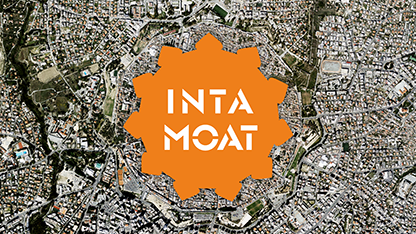
|
|
Situation
|
The public space of the Moat and the Bastions from the Venetian Walls of Nicosia are underused by citizens and visitors.
Spontaneous uses of the public space, varied and under-planned, are currently present and can be considered as a good starting point.
We propose a tool to better enable the public space's uses, and to inspire new ones for a diverse set of users.
|
|
Objective
|
Enabling citizens and visitors' better use of the Moat area,
enhancing the perception of an overall coherent public space by:
- Developing a new identity of the public space of the moat, based on collective use and management;
- Introducing collaboration and ICT in governing the urban commons through the tool "Inta Moat".
|
|
About the platform
|
INTA MOAT facilitates temporary accommodation of community managed activities in the spaces of the moat.
This platform allows the users to experience the moat as a coherent public space.
It is an attempt to re-establish the connection of the historical value of the old city wall and the moat,
with the citizens' various contemporary social, physical and communal activities.
A key element of 'Inta Moat' is the self-organising use of the moat monument for the city's common good.
User scenario:
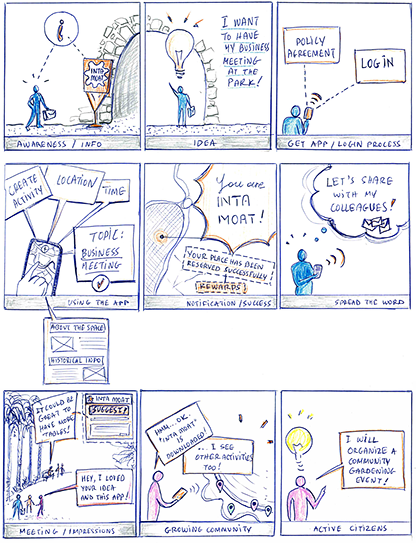
|
|
Interface Concepts
|
Mobile Interface
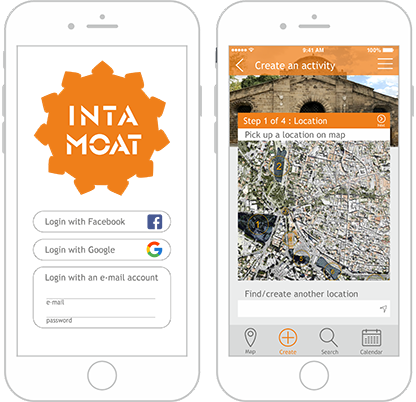

Desktop Interface
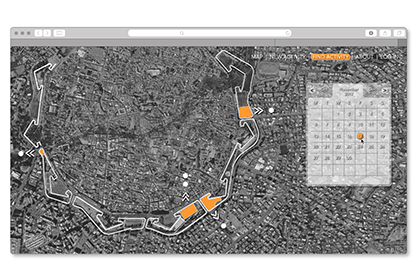
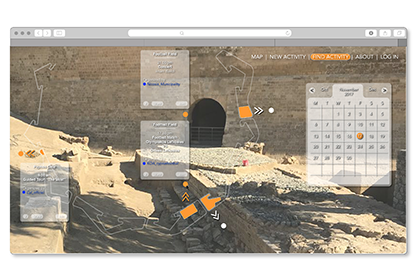
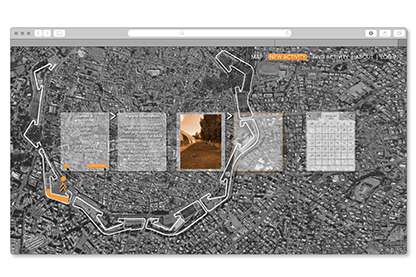
|
|
Group
|
Francesco Bagni
Valentino Canturi
Mariza Daouti
Joatan Preis Dutra
Charalampos Ioannou
Maria Kikidou
Athanasia Panagiotidi
Marianna Patelida
Eftychios Savvidis
Harry Varnavas
|
|
Download Article
|
 INTA MOAT: a tool for governing the urban commons
INTA MOAT: a tool for governing the urban commons
(24 pages, in PDF format)
|
|
Download Final Presentation
|
 INTA MOAT
INTA MOAT
(48 slides, in PDF format)
|
| |
|


|
 Contact
Contact










 Contact
Contact









